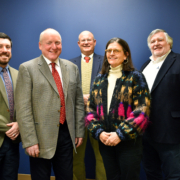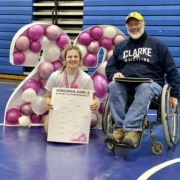By Cathy Kuehner
When the Circuit Court established the Clarke County Board of Supervisors in 1870, the county was divided into four townships for representation: Battletown, Chapel, Greenway, and Long Marsh. Over the past 152 years, townships became districts, district names changed and, in 1991, a fifth district was added as the result of Census data and a growing population.
One thing has not changed: Where you live determines where you vote and in which election districts you vote.
A mayor and Town Council represent everyone who lives within Berryville and Boyce town limits. All Clarke County residents, including those who live in Berryville and Boyce, are represented by one of five Supervisors, who collectively make decisions for the county and voice local concerns to elected officials in Richmond. Members of the Virginia General Assembly (delegates and senators) and Congress represent the residents from their districts at the state level.
Virginia General Assembly and congressional districts were recently redrawn based on 2020 Census data. The Virginia Supreme Court approved this redistricting on Dec. 28, 2021. Clarke County was in state Senate District 27, represented by Sen. Jill Vogel, R-Upperville, and the 10th Congressional District, represented by Democratic U.S. Rep. Jennifer Wexton. Parts of the county also are in two state House districts: the 10th, represented by Del. Wendy Gooditis, D-Boyce; and the 33rd, represented by Del. Dave LaRock, R-Hamilton.
With redistricting, Clarke County, surrounding counties, and the City of Winchester are in state Senate District 1 (a new district) and House District 31. Clarke County is also part of the newly redrawn 6th Congressional District.However, the elected officials who currently represent Clarke County — Vogel, Wexton, Gooditis, and LaRock — continue to represent the county until their terms expire; that is January 2023 for Congress and January 2024 for the state house and senate.
At the county level, the Board of Supervisors has determined that Clarke’s population has increased proportionally across the county, so its district boundaries will not change.
Census data shows that Clarke County’s population increased from 14,034 in 2010 to 14,807 in 2020.
According to County Administrator Chris Boies, each of the county’s five voting districts should have an “ideal population” of 2,961 based on population growth and state laws. Specifically, districts must be within plus or minus 5 percent of that number, or have a population between 2,813 and 3,109, he said.Each Clarke district is within that range based on 2020 Census data.
• Berryville District has 2,997 residents (2,852 in 2010)
• Buckmarsh District has 2,827 residents (2,854 in 2010)
• Millwood District has 3,021 residents (2,729 in 2010)
• Russell District has 3,082 residents (2,896 in 2010)
• White Post District has 2,880 residents (2,703 in 2010)
As this edition of Clarke Monthly went to press, the Board of Supervisors held a public hearing on Feb. 15 to make two changes to the Code of Clarke County. The first change simply updates the population for each district using 2020 Census information. The second is technically a correction, changing the “voter election district” to the accurate term “voter election precinct” for the central absentee voting.
Except for occasional special elections or primaries in the spring, all voters go to the polls in November to elect officials who begin serving their terms in January.
Director of Elections & General Registrar Barbara Bosserman said the Clarke County Office of Elections will send letters to all registered voters prior to the next election. The letters will outline changes to election districts and remind voters where they cast their ballots. Polling locations are not changing, Bosserman said.
The next election for Clarke County Supervisors is November 2023; their four-year terms begin in 2024.
“Supervisors are the governing body for the county,” explained Boies, who as county administrator oversees the day-to-day operations of county government and reports to the Board.
The Board is responsible for the budget, ordinances, land-use decisions, and it sets priorities for county government. Supervisors also correspond with state and federal officials to make the needs of Clarke residents known.
Individually, each Supervisor responds to constituent concerns and requests. If warranted, a supervisor will take concerns to the full Board.Residents also can express concerns during each monthly Board meeting. Regular meetings on the third Tuesday of the month include Citizens Comment periods, when individuals may speak for three minutes on any subject.
David Weiss, who was first elected to the Board in 2003, has served as its chair since 2015. He represents the Buckmarsh District. Buckmarsh was carved out of the Berryville District after the 1990 Census and redistricting in early 1991.
At its January organizational meeting, the Board unanimously elected Millwood District Supervisor Terri Catlett to serve as vice chair. She was first elected in 2015.
White Post District Supervisor Bev McKay was first elected in 2011, and Supervisor Doug Lawrence was elected in 2019 to represent the Russell District.In May 2020, Matthew Bass was appointed by the Board to fill the unexpired Berryville District Supervisor term of Mary Daniel after she was named a General District Court judge for the 26th Judicial District. Bass then won a special election in November 2020.
Clarke County was created on March 8, 1836, when the state Senate officially separated the new county from Frederick County. After the Constitution of 1870 established the Clarke County Board of Supervisors, the first to step up and serve were Philip H. Powers, John Morgan, John M. Gibson, and John R. Nunn.From the beginning, Clarke Supervisors have placed high value on the county’s natural resources and agrarian heritage. A March 1936 editorial in the Clarke Courier newspaper concluded, “The duty, therefore, has become ever more insistent upon the men and women of this generation in Clarke County to care well for this lovely land which is now observing its one hundredth birthday as a separate county. In fertilizing the soil they are preserving the interests of their children for the years to come so that its richness may be preserved forever like the grandeur of the Blue Ridge Mountains that encircle this county with their ageless might.”
What was true then, remains true now.
Find more information about your Board of Supervisors, including a district map, meeting agendas, and contact information, at www.clarkecounty.gov. Use the drop-down menu under “Government,” go to “Boards & Commissions,” and click on “Board of Supervisors.”









